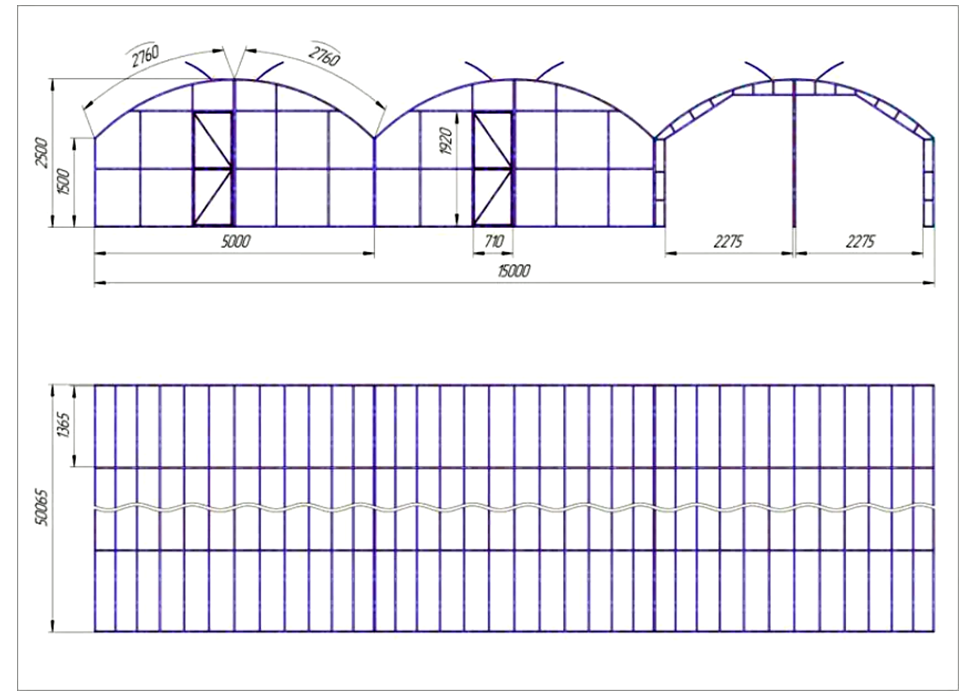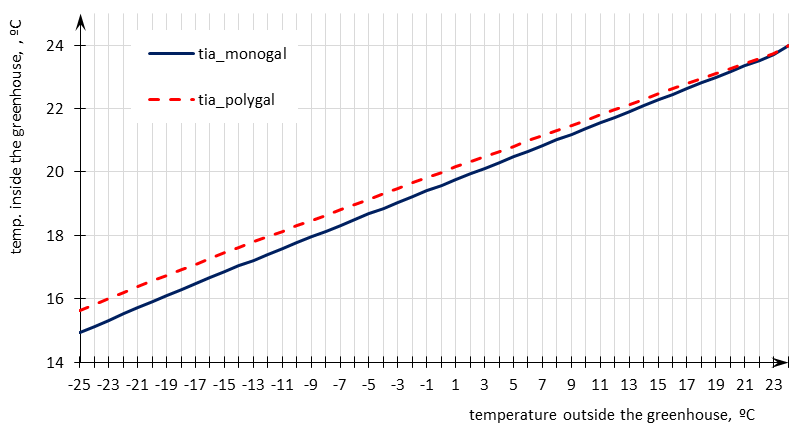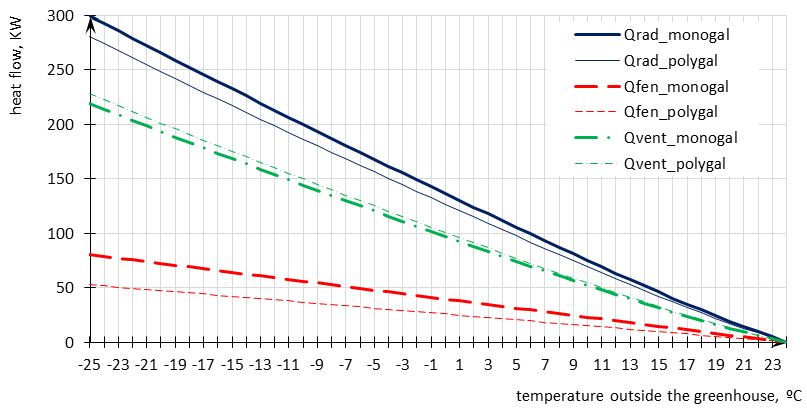DEVELOPMENT OF PROCEDURE FOR DETERMINATION OF CHARACTERISTICS OF HEATED POLYCARBONATE GREENHOUSES
РАЗРАБОТКА МЕТОДИКИ ОПРЕДЕЛЕНИЯ ХАРАКТЕРИСТИК ОТАПЛИВАЕМЫХ ТЕПЛИЦ ИЗ ПОЛИКАРБОНАТА
Научная статья
Ильичев В.Ю.*
ORCID: 0000-0003-1017-5544,
Калужский филиал Московского государственного технического университета имени Н.Э. Баумана, Калуга, Россия
* Корреспондирующий автор (patrol8[at]yandex.ru)
АннотацияЦелью работы является разработка практического метода проектирования теплиц, позволяющего исследовать характеристики их режимов эксплуатации.
На основе уравнений теплового и баланса, составленных для ограждений теплицы и для почвы при стационарном режиме тепломассообмена, разработана расчётная программа на языке Python. Данный язык выбран по причине наличия специальной библиотеки для вычисления теплофизических параметров влажного воздуха.
В качестве примера рассчитана теплица с инфракрасными обогревателями и ограждениями из поликарбоната разных марок. Анализ результатов позволил выбрать для данной теплицы оптимальное сочетание типа поликарбоната и способа вентиляции.
Намечены цели будущих разработок при решении задач проектирования систем обогрева и оптимизации ограждений теплиц.
Ключевые слова: расчёт теплиц, поликарбонат, тепломассообмен, язык Python, модуль CoolProp.
DEVELOPMENT OF PROCEDURE FOR DETERMINATION OF CHARACTERISTICS OF HEATED POLYCARBONATE GREENHOUSES
Research article
Ilichev V.Yu. *
ORCID: 0000-0003-1017-5544,
Kaluga Branch of Bauman Moscow State Technical University, Kaluga, Russia
* Corresponding author (patrol8[at]yandex.ru)
AbstractThe purpose of the work is to develop a practical method for designing greenhouses, which allows to investigate the characteristics of their operating modes.
Based on equations of thermal and humidity balance, compiled for greenhouse fences and for soil in a stationary heat and mass exchange mode, a calculation program in the Python language was developed. This language is selected due to the presence of a special library for calculating thermophysical parameters of wet air.
As an example, a greenhouse with infrared heaters and polycarbonate fences of various grades is designed. Analysis of the results made it possible to choose for this greenhouse the optimal combination of type of polycarbonate and ventilation method.
The goals of future developments in solving problems of designing heating systems and optimizing greenhouse fences are outlined.
Keywords: greenhouse calculation, polycarbonate, heat and mass exchange, Python language, CoolProp module.
IntroductionSolving the problem of providing the population with agricultural products in the cold season is possible due to the construction of industrial greenhouses. When designing them, it is necessary to use modern accurate calculation methods and materials of fences (the most promising of which is polycarbonate).
Currently, infrared heaters [1] are most often used to heat greenhouses in cold times of year, which are located in upper part of greenhouses, while soil heating is due to thermal radiant energy. After that, the soil gives part of the thermal energy to the air, and part goes into its deep layers.
When designing, it is necessary to calculate heat costs, reducing which, it is possible to increase economic efficiency of using greenhouses.
As for any room, the basis of the calculation method should be compilation of thermal and material balances of greenhouse room under known environmental conditions [2].
MethodsThe study of processes occurring in greenhouses is based on solution of system of equations for the case of steady-state heat exchange mode [3]:
- Equation of thermal balance of greenhouse fence, showing that radiant heat flow coming from infrared emitter is spent on losses due to heat transfer through fences and loss with air exiting through the ventilation openings.
- Equation of thermal balance of soil surface, taking into account the evaporation of moisture from the surface. According to it, heat flow from the emitter goes to thermal radiation of soil surface, convective part of heat exchange between soil and enclosure and to heat flow to evaporate moisture from soil surface.
Solution of the system of the equations allows to find the power of emitters at given temperatures of soil and outdoor air. This solution is most expedient to find by sequential approximation using a computer program. For creation of the program freely extended and popular Python [4] programming language with module CoolProp [5] for determination of thermophysical parameters of air is used.
Initial parameters for the calculation are [6]: dimensions of greenhouse fence and ventilation openings, surface area of soil, reflection and absorption coefficients of soil and fencing, parameters of external and internal air, temperature of soil surface.
The program algorithm consists of performing the following operations:
- Import function libraries for Python:
- Math for calculation of trigonometric functions;
- Numpy for working with data arrays (calculated at different initial parameters-arguments and later used to plot functions);
- CoolProp to find thermophysical properties of dry and wet air (enthalpy and moisture content);
- Matplotlib for constructing graphs based on the results of calculating arrays of arguments and functions.
- Assigns the values of the specified initial parameters to the variables.
- Creation of arrays for entering arguments: variable temperature of external and internal air, and calculated values of functions during the program: required power of an infrared emitter and thermal losses of every types.
- Organization of two nested calculation loops. In the external loop, the value of the first argument - ambient air temperature (for further plotting) changes. In the internal loop, the second argument changes step by step - the temperature of the internal air. The calculation of the internal cycle is considered complete if the equality of heat energy released by the heaters and lost through the fences is achieved.
As an example, heat regime of greenhouse was analyzed (see Figure 1) for the annual outside air temperature range characteristic of middle region of Russia [7].
Fig. 1 – Sketch of the industrial greenhouse to be calculated
The first option under consideration for organizing ventilation of the greenhouse was natural ventilation. Greenhouse fences are made of polycarbonate with a recommended thickness of 10 mm [8]. Two types of polycarbonate cross-section were compared - monolithic Monogal and cellular Polygal, characteristics of which are accepted according to their manufacturer's information.
Figure 2 shows results of calculation of air temperature inside the greenhouse.
Fig. 2 – Dependence of air temperature inside the greenhouse on outdoor air temperature for fences from monolithic (Monogal) and cellular (Polygal) polycarbonate
We see that outdoor temperature within the given year-round range of its change in the greenhouse, is maintained from 15-16 to 24 °С, which is quite acceptable for growing vegetables, for example.
The dependence of required power of infrared emitters Qrad on the outdoor temperature is also obtained, shown in Figure 3. Heat energy losses through fences Qfen and through vents Qvent are also shown separately.
Fig. 3 – Dependence of infrared emitters power, as well as thermal losses through fences and ventilation holes, on the outdoor temperature for fences from monolithic (Monogal) and cellular (Polygal) polycarbonate
It can be seen from the graphs that when enclosures are arranged from both types of polycarbonate, thermal energy loss is approximately the same (for cellular construction a little lower). When using cellular polycarbonate, losses through fences are significantly reduced, but they are several times less than ventilation losses and the total losses are not significantly affected.
Discussion
According to the presented calculation results, it can be concluded that when organizing the greenhouse fencing, monolithic Monogal and cellular Polygal cross sections of polycarbonate are suitable for natural air ventilation, but use of cellular type is somewhat more preferable.
According to the same program, calculation was made when organizing the ventilation of the greenhouse using fans. According to results of the calculation, graphs were drawn showing that for any type of polycarbonate the air temperature in greenhouse ranges from 1 to 24 °С, which is completely unacceptable for growing plants, and total heat flow at - 25 °С is more than 2 times higher than heat loss in natural circulation. Therefore, forced ventilation is not applicable to the greenhouse.
Conclusion
The following tasks were achieved:
- greenhouse calculation methodology has been developed;
- an algorithm and a program for calculating temperature characteristics of greenhouses with infrared heaters have been developed;
- obtained temperature characteristics of a large greenhouse from monolithic and cellular polycarbonate, with natural and forced ventilation; based on results of calculations, conclusions were made about admissibility and preference of using considered technical solutions.
The calculation program can be used to design any greenhouses type using infrared radiation heaters. The program allows you to choose the optimal way to organize ventilation, correct size and type of fences, size of ventilation openings, vary heat reflecting properties of soil and many other parameters.
Based on the results of calculating the maximum thermal losses, someone can select necessary source of infrared radiation.
Further improvement of temperature regime of greenhouses is possible by using combined heating systems [9] and new research methods [10].
| Конфликт интересов Не указан. | Conflict of Interest None declared. |
Список литературы / References
- Kim D. Comparative Study on the Reduction Effect in Greenhouse Gas Emissions between the Combined Heat and Power Plant and Boiler / D. Kim, T. Kim, Y. A Park // Sustainability. - 2020. - №12. – P. 44-55.
- Golub G.A. Modelling the work of closed system of heating and ventilation of greenhouses / G.A. Golub, O.I. Kepko // INMATEH - Agricultural Engineering. - 2017. - Vol. 52.- № 2. - P. 85-90.
- Irineo Lopez-Cruz Development and analysis of dynamical mathematical models of greenhouse climate: A review / Irineo Lopez-Cruz, Efrén Fitz-Rodríguez, Salazar Moreno Raquel. // European Journal of Horticultural Science - 2018. - №5. – P. 269-279.
- Hosseini R. Improving engagement in program construction examples for learning Python programming. / R. Hosseini, K. Akhuseyinoglu, P. Brusilovsky et al. // International Journal of Artificial Intelligence in Education. - 2020. - №2. - P. 299-336.
- Abolpour B. AN Empirical correlation relating equilibrium compressibility factors for pure substances / B. Abolpour, M. Rahmanzadeh // International Journal of Thermophysics. - 2019. - Vol. 40.- №10. - P. 91.
- Uzakov G.N. Technical and economic calculation of combined heating and cooling systems vegetable store-solar greenhouse / G.N. Uzakov // Applied Solar Energy. - 2012. - Vol. 48. - №1. - P. 60-61.
- Sharafutdinov R. Application of active temperature logging at oilfields of Russia / R. Sharafutdinov, R. Valiullin, A. Ramazanov, V. Fedotov, A. Sadretdinov, M. Zakirov // Society of Petroleum Engineers - SPE Russian Oil and Gas Exploration and Production Technical Conference and Exhibition 2012.- 2012. - P. 1628-1645.
- O'Connell P.A. Exceptional property changes in ultrathin films of polycarbonate: glass temperature, rubbery stiffening, and flow / O'Connell P.A., Wang J., Ishola T.A., McKenna G.B. // Macromolecules. - 2012. - Vol. 45. - №5. - P. 2453-2459.
- Pavlov M.V. Winter greenhouse combined heating system / M.V. Pavlov, D.F. Karpov, A.A. Sinitsyn, A.G. Gudkov // Magazine of Civil Engineering. - 2020. - №3(95). - P. 131-139.
- Kovac M. Using designbuilder to analyse the indoor environment in greenhouse / M. Kovac, K. Kovacova // 16th international multidisciplinary scientific geoconference SGEM 2016. Sofia, - 2016. - P. 787-794.



